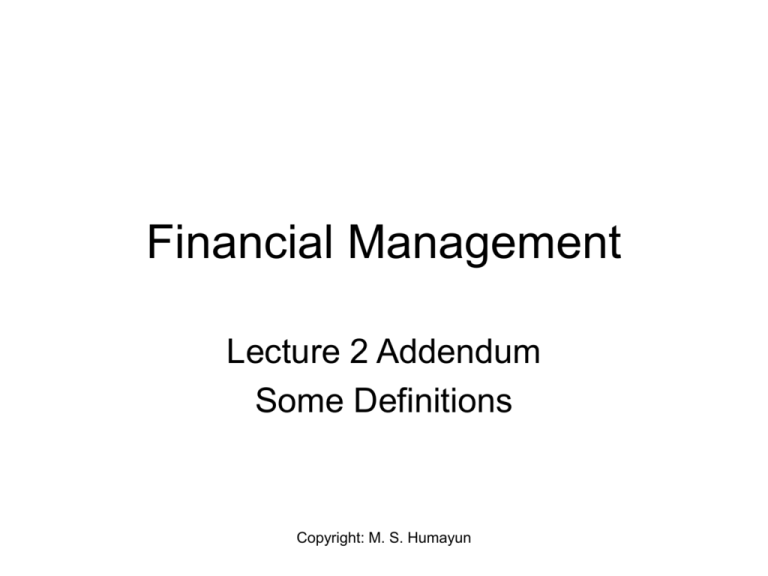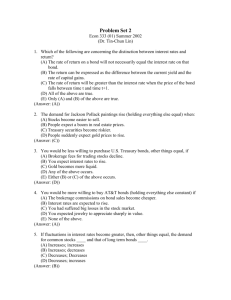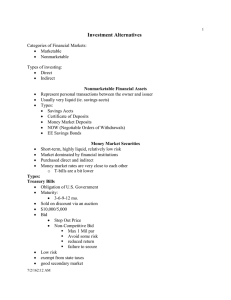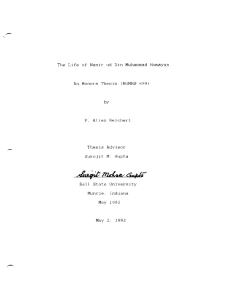Financial Management
advertisement

Financial Management Lecture 2 Addendum Some Definitions Copyright: M. S. Humayun Real Assets vs Securities • Real Assets – Tangible Assets like land, house, equipment, car, wheat, fruits, cotton, computers, etc. • Securities – Piece of paper representing a claim on an asset • Direct Securities: Stocks and Bonds – Value depends on the cash flows generated by the underlying assets. Use Discounted Cash Flow (DCF) techniques. • Indirect Securities: Derivatives, Futures, Options – Value depends on the value (market price) of the underlying assets Copyright: M. S. Humayun Bonds • Internationally, the most common way for companies to raise financing and funds. • A Bond is a long-term debt contract (on paper) issued by the Borrower (Issuer of the Bond ie. a company that needs money) to the Lenders (Bond Holder or Investors ie. Banks, financial institutions, and private investors). • Bonds Issued represent Liabilities (on the Balance Sheet) • A Bond requires the Borrower to pay a pre-determined amount of interest regularly to the Lender. The interest may be Fixed or Floating. • Types of Bonds: – Debentures: Unsecured – no asset backing – Mortgage Bond: Secured by real property ie. Land, house – Others: Eurobond, Zeros, Junk, etc. Copyright: M. S. Humayun Stocks (or Shares) • Most common source of raising funds under Islamic Shariah. • Stocks (or Shares) are paper certificates representing ownership in a business. Therefore, if a company has issued 1 million shares and even if you own 1 share only, you are a part owner (or Shareholder) ! • Represents Equity (on the Balance Sheet) • The Stock certificate lasts as long as the company does. Note: Perpetual Concern • Shareholders have a Residual Claim on whatever Net Income (or Profit) and Assets are left over after the Bond Holders have been paid off. • Types of Stocks (or Shares): – Common Stock: True owners. Shareholders receive Dividends or portion of the Net Income (which the management decides NOT to reinvest into the company in the form of Retained Earnings) in proportion to the number of shares they hold. The Dividend is uncertain. Common Stock holders have voting rights to elect a Board of Directors. – Preferred Stock: A stock with a predetermined or fixed dividend. The Preferred Dividend is guaranteed and must be paid out before the Common Stock Dividend. Copyright: M. S. Humayun Where Do Bonds & Stocks Appear on the Balance Sheet? Own Bonds Issued by Company to Raise Cash Stocks & Bonds Purchased as Investment Own Stock Issued by Company to Raise Cash Copyright: M. S. Humayun Value • Book Value – Value as shown on the Balance Sheet based on historical cost (or purchase price) and accumulated depreciation • Market Value – Value of asset as observed in the market. Depends on the Supply & Demand and negotiations between Buyers & Sellers. • Liquidation Value – Value if the company were closed down and its assets were sold individually. • Fair Value or Instrinsic Value – Present Value of the working assets’ future cash flows. Use Discounted Cash Flow (DCF) technique. – If the Intrinsic Value is less than the Market Value, then the asset is “undervalued” in the mind of the investor Copyright: M. S. Humayun









